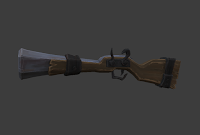PROJECT 3: Unwrap & Texture
Back to the fun stage! Finally! Well, not the unwrap per se, that's part maths, and maths is evil. But texturing! I studied the brief a lot for this stage, and I'm glad to say I think I learned the most out of it as well. Long gone are the times where I trial-errored inputting the roughness/metallic values in thousand times because I did not understand what any of them does and I cried myself to sleep not knowing where I went wrong when I finally put my assets into UE4 and they all just looked like dark, shiny unicorn poop. I finally got it! The white means matte, the dark means disco balls!
The source of my epiphany was mainly me trying to follow Matt Wilkins' amazing breakdown and working on the textures in Photoshop. Breaking everything down to Photoshop layers helped immensely. I helped myself out by importing my bakes (from Substance) to 3DCoat which has an awesome bridge with Photoshop, so I was not in blind and I saw every change I made on the texture in the viewport immediately (and could handpaint on the model directly as well). I still don't get why Substance only has an "Export-to-Photoshop" feature, biiiiiig let down.
The source of my epiphany was mainly me trying to follow Matt Wilkins' amazing breakdown and working on the textures in Photoshop. Breaking everything down to Photoshop layers helped immensely. I helped myself out by importing my bakes (from Substance) to 3DCoat which has an awesome bridge with Photoshop, so I was not in blind and I saw every change I made on the texture in the viewport immediately (and could handpaint on the model directly as well). I still don't get why Substance only has an "Export-to-Photoshop" feature, biiiiiig let down.
As per Matt Wilkins' suggestion in his breakdown, I created a tileable 'dirt-colour-interest-detail' texture which I then used in almost every asset (by just changing colours via PS's Selective Color). Big help in wood texturing, more subtle in fish skeleton bone, added great hints of hues in the golden bird cage and overall made the process much more enjoyable than if I had to add interest individually by hand to every asset :) I still did some overpaints because sometimes it was hard to adhere the texture to the UVs (note for next time: this is why you should assemble UVs as straight as you can, and if possible, all in the sime direction!). ¨

Another thing which blew my mind was the use of Curvature Map. I thought I had lost all the details from Zbrush when baking, but this thing - man, this awesome thing! It just brings it all back! It took me some time to figure out the opacity and blending mode settings and in some cases, I had to clean it up manually, but if there was an MVP award for most useful texturing trick, Curvature Map takes it home, no question. With lacquered wood and some other assets, I boosted the curvature map by lassoing over some wear and tear and the result was even nicer.
In the brief it was advised not to add AO to textures, but with some assets I went and did it anyway, just very subtly.
At the end of the texturing process, I brought all assets back to Substance Painter just because I like the shaders and rendering there more. I exported the final Targas from there as well, with Roughness in Blue channel, nothing in Green channel, metallic in Red channel, as it was asked of us in the brief. Overall, this must have been the most fun I've had when texturing in a while and I would love to work in this style once again after I finish this project!








Comments
Post a Comment